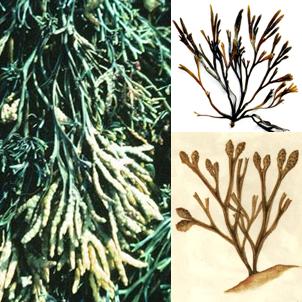| Authority: Decaisne & Thuret |
Type species: Pelvetia canaliculata (Linnaeus) Decaisne & Thuret |
|
| Commercial species: siliquosa (SIL) & spp. |
|
| Common names: Caisíneach, Channel wrack, Channelled Wrack, Cow Tang, Dubhlamán, Dúlamán, Mac Con Iomaire, Múirín na Muc, Yezo-ishige |
|
|
| Classification: Eukaryota, Phylum Heterokontophyta, Order Fucales, Family Fucaceae. |
|
| AlgaeBase names and species: 14 names - 2 current as of 12-2001. |
|
|
|
|
| DiveBorneo SeaPlant Utility Rating |
 |
Minor polymer source - source of fucoidan - not farmed |
|
 |
Harvesting must use good conservation practices to avoid habitat damage. |
|
|
Description
Dichotomously branching fronds up to about 15 cm long and brown or dark green in colour. Has an appearance somewhat like that of Fucus spp. but generally has more narrow fronds. Some species live 3-4 years. The fronds of some species are curled longitudinally and thus form a channel. |
Habitat
Generally found in the high intertidal zone of rocky shores. Can tolerate ultra sheltered to moderately exposed conditions. |
|
 |
| click images & go to sources |
|
Pelvetia production
click country to go to GIS |
Tons per annum
wild harvest |
Tons per annum
cultivated |
| North Korea |
n/a |
0 |
| South Korea |
n/a |
0 |
| Total |
n/a |
n/a |
0 |
|
Production
Production figures are being sought. |
Biology & Agronomy
Wild harvest. |
Chemistry
Contains alginates and fucoidan, an anti-coagulant. |
Processing
We have several monographs in progress covering analytical procedures post-harvest treatment and process technology. Check the processing index for available web pages and monographs. |
Products, Uses & Applications
Source of alginates and fucoidan, an anti-coagulant. Also used as a component in lotions and nutraceutical preparations.
| List of species' uses and community affiliations |
|
| Genus |
GenID |
SpID |
Species |
Uses |
Communities |
| Pelvetia |
PE |
SIL |
siliquosa |
FH |
SV |
|
| click to relevant uses or communities on the index/legend table below>>> |
|
|
|
|
 to uses to communities to uses to communities  |
|
|
|
| Pelvetia is most strongly associated with the Seavegetables community. |